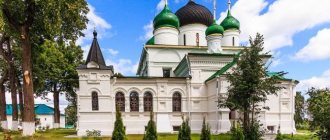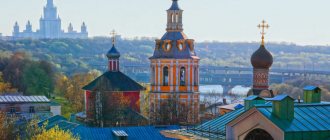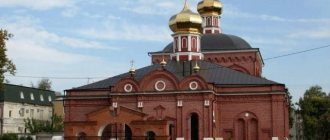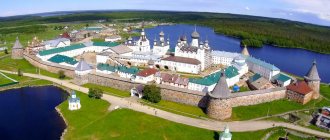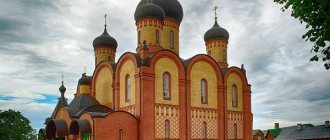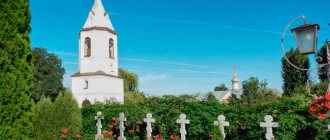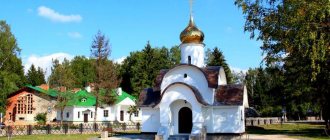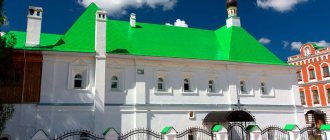Solovetsky Monastery
Article: Solovetsky Monastery - a powerful fortress on the Solovetsky Islands of Russia
View of the Solovetsky Monastery
Solovetsky Monastery is an independent monastery of the Russian Orthodox Church. It is located in the White Sea on the Solovetsky Islands. The foundation of the monastery dates back to the 40s of the 15th century, when the Monk Zosima and his friend chose Bolshoi Solovetsky Island as their place of residence. He made such a choice not by chance - the monk saw a church of unprecedented beauty.
Recognizing his dream as a sign from above, Zosima began building a wooden temple with a chapel and a refectory. With its construction he honored the Transfiguration of the Lord. After a short period of time, Zosima and German built a church. With the appearance of these two buildings, which later became the main ones, the arrangement of the monastery territory began. Subsequently, the Archbishop of Novgorod issued a document to the monastery confirming its eternal ownership of the Solovetsky Islands.
Holy Vvedenskaya Optina Hermitage
Article: Holy Vvedenskaya Optina Hermitage - repository of the relics of the holy elders
View of the Holy Gates of the Holy Vvedenskaya Optina Hermitage
The Holy Vvedenskaya Optina Hermitage is a stauropegial monastery, the servants of which are male monks. Its creator was the robber Opta, or Optia, who at the end of the 14th century. repented of his actions and accepted monasticism. As a clergyman he was known under the name Macarius. In 1821, a monastery was established at the monastery. It was inhabited by the so-called hermits - these are people who spent many years in complete solitude. The mentor of the monastery was the “elder”. Over time, Optina Pustyn turned into one of the leading spiritual centers. Thanks to numerous donations, its territory was replenished with new stone buildings, a mill and land. Today the monastery is considered a historical monument and has a different name - “Museum of Optina Pustyn”. In 1987, it was included in the list of objects of the Russian Orthodox Church.
History of monasticism
“Monasticism is external and internal. You cannot ignore the external, but you cannot be satisfied with it alone either. The external alone without the internal even brings harm. External monasticism can be likened to plowing the earth. No matter how much you plow, nothing will grow if you don’t sow anything. Inner monasticism is sowing, and millet is the Jesus Prayer. Prayer illuminates the entire inner life of a monk, gives him strength in struggle, and is especially necessary when enduring sorrows and temptations...”
(Reverend Barsanuphius of Optina).
A monk (Greek μοναχός - single, single) is a member of a religious community, in accordance with a vow (oath) leading an ascetic life either within the monastic community (brotherhood), or in solitude, as a hermit.
These words of St. Hesychius fully reflect the life of a true monk. What is monasticism and why are monasteries needed in the modern world?
A monk is an Orthodox Christian who has renounced worldly life and taken vows:
– virginity (a monk cannot marry);
– obedience (a monk must obey the abbot in everything, without relying on his own will and thoughts);
– non-acquisitiveness or poverty (a monk should not have any property, everything is in common with other monks).
Monasticism originated in Egypt in the second half of the 3rd century. The first monk was Anthony the Great, he lived in the desert for more than 90 years, endured difficult trials: hunger, thirst, cold, heat, temptations and devilish attacks. People from all over the world flocked to such great ascetics and settled nearby. Monasteries began to form. In them the monks lived and worked together under the strict guidance of an experienced elder (abbot) according to strict rules.
Novodevichy Convent
Article: Novodevichy Convent - the oldest Orthodox monastery for women
View of the Novodevichy Convent from Novodevichy Ponds Park
The Novodevichy Convent, built in the 16th century, was at that time located on Samsonov Meadow. Nowadays this area is called the Maiden Field. The cathedral church at the monastery was built in the likeness of the Assumption Cathedral - the “neighbor” of the Moscow Kremlin. The monastery walls and towers were built in the 16th – 17th centuries. In general, the architecture of the monastery conveys the “Moscow Baroque” style. The monastery owes its fame to the Godunov family. Boris Godunov lived here before his election as king with his sister Irina. Irina Godunova took monastic vows with the name Alexander and lived in separate chambers with a wooden tower. At the end of the 16th century. The territory of the monastery was replenished with stone walls and a dozen towers. In appearance, they resembled Kremlin buildings (there were square towers in the walls, and round ones in the corners). Their upper parts were decorated with teeth. Today the Novodevichy Convent combines both a museum and a monastery.
Kirillo-Belozersky Monastery
Article: Kirillo-Belozersky Monastery: beauty and grandeur, history and facts
View of the Kirillo-Belozersky Monastery from the Russian North National Park
The Kirillo-Belozersky Monastery is located on the shores of Lake Siverskoye. It owes its appearance to St. Cyril, who founded it in 1397. Construction began with the arrangement of a cell-cave and the installation of a wooden cross over it. In the same year, the illumination of the first shrine took place - it was a wooden church built in the name of the Dormition of the Blessed Virgin Mary. By 1427, there were about 50 monks in the monastery. In the first half of the 16th century. a new life begins at the monastery - all Moscow nobles and kings began to regularly come to it on pilgrimage. Thanks to their rich donations, the monks quickly built up the monastery with stone buildings. Its main attraction is the Assumption Cathedral. Appearing in 1497, it became the first stone building in the North. The monastery complex underwent various architectural changes until 1761.
Alekseevsky Monastery in Uglich
Most of all, pray for peace. Words to the sisters.
Abbess Feosemni
RUB 264
An Orthodox women's monastery on the ancient Fire Mountain near the Kamenny Stream, founded back in 1371 by the monk Adrian, with the consent of Dmitry Donskoy himself.
The first stone buildings began to be erected here in 1534, and after the invasion of Polish-Lithuanian troops, who killed all the monks in 1609, the Assumption Church of unknown beauty was erected. Here in 1698 the disgraced archers who rebelled against Peter the Great were kept.
Also on the territory of the parish is the Alexeevskaya Church of the 16th century, completely rebuilt in the 19th century, and the Cathedral of St. John the Baptist
, famous for its stunning tiles.
Cathedral of John the Baptist
Valaam Monastery
Article: Spaso-Preobrazhensky Valaam Monastery - a special monastery of the Russian land
General view of the Valaam Monastery
The Valaam Monastery is a stauropegic institution of the Russian Orthodox Church, which occupied the islands of the Valaam archipelago (Karelia). The first mentions of it are found in chronicles of the 14th century. Thus, “The Legend of the Valaam Monastery” informs about the date of its foundation - 1407. Within a couple of centuries, 600 souls of monks lived in the monastery, however, due to repeated invasions by Swedish troops, the island began to decline.
After another 100 years, the territory of the monastery began to be filled with cell buildings and auxiliary premises. But the main buildings of the monastery courtyard were the Assumption Church and the Transfiguration Cathedral. Wanting to create the New Jerusalem from their own monastery, the Valaam ascetics used the names of the New Testament period when arranging its sites. Over the years of its existence, the monastery has undergone many changes, and to this day it remains one of the attractive historical monuments of Russia.
Alexander Nevsky Lavra
Article: Alexander Nevsky Lavra - an architectural complex built in memory of the Great Victory in the Battle of the Neva
General view of the buildings of the Alexander Nevsky Lavra
The Alexander Nevsky Lavra was founded in 1710 at the junction of the Monastyrka River with the Neva. The decision to build it was made by Peter I himself, who wished to perpetuate the victory over the Swedes in 1240 and 1704 in this area. In the 13th century. Alexander Nevsky fought against hordes of Swedes, so he was subsequently canonized for good deeds before the Fatherland. The monastery built in his honor was popularly called the Alexander Temple, and with its construction the expansion of the territory of the Holy Trinity Alexander Nevsky Monastery, or Lavra, began. It is noteworthy that the monastery buildings were located “at rest”, i.e. in the shape of the letter “P” and were decorated with churches in the corners. The landscaping of the yard consisted of a garden with a flower bed. The main holiday of the Lavra is the day of September 12 - it was on this date, back in 1724, that the holy relics of Alexander Nevsky were transferred.
Monasteries of Russia, Orthodox, active, with miraculous icons
There are Orthodox monasteries in Russia that are still active today. But the main thing is that they contain miraculous icons, which have been faithfully worshiped by Christians around the world for centuries. These are the following shrines:
- Vladimir Icon of the Mother of God, which is located in the Church of St. Nicholas in Tolmachi;
- Tikhvinskaya - in the Church of the Tikhvin Icon of the Mother of God;
- icon “Recovery of the Lost” – Church of the Ascension of the Word;
- “Merciful” – Conception Convent;
- Iveron Icon of the Mother of God - in the chapel of the same name;
- Ugresh icon of St. Nicholas;
- “Quench my sorrows” - St. Nicholas Church, Kuznetsy.
The best article for you, go to: Ipatiev Monastery Kostroma
All these icons are of great importance and are truly wonderful, for each of them helps to strengthen physical health and cope with moral problems, and bestows long-awaited humility, faith and God's grace. Orthodox people from all over the world come to them every year in order to learn the word of the Great Teacher and find their true purpose in life.
Orthodox operating monasteries in Russia are not only the greatest monuments of architecture and the history of Christianity, known both in Russia and throughout the world, but also a great power over which time has no power, because it contains the main thing - unshakable faith in the Lord, which illuminates the righteous path to the true and real meaning of existence - eternal life.
Active monasteries in Russia, list:
- Adrian Poshekhonsky Monastery, Yaroslavl region, Poshekhonsky district, Andrianova Sloboda village, foundation date: 1540
- Alexander-Athos Zelenchuk men's hermitage, Karachay-Cherkess Republic, Zelenchuk district, village. Nizhny Arkhyz, founded: 1889
- Alexander Nevsky Convent, Moscow region, Taldomsky district, Maklakovo village, date of foundation: 1906
- Alekseevskaya Hermitage of the Pereslavl Feodorovsky Monastery, Yaroslavl region, Pereslavl district, Novoalekseevka village, date of foundation: end of the 19th century
- Ambrosiev Nikolaevsky Dudin Monastery, Nizhny Novgorod region, Bogorodsky district, Podyablonnoe village, foundation date: no later than the 2nd half. XIV century
- St. Andrew's Hermitage of the Solovetsky Monastery, Arkhangelsk region, Primorsky district, Solovetsky Islands, foundation date: beginning. XVIII century
- Artemiev-Verkolsky Monastery, Arkhangelsk region, Pinezhsky district, village. New Way, date of foundation: 1649
- Annunciation Convent, Astrakhan, north-west. street corner Sovetskaya and st. Kalinina
- Annunciation Ion-Yashezersky Monastery
- (Yasheozersk Desert) Republic of Karelia, Prionezhsky district, ur. Yashezersky Monastery, foundation date: late. 16th century
- Annunciation Krasnoyarsk Convent, Krasnoyarsk, st. Lenina, 13-15, date of foundation: 1995
- Annunciation Monastery in Dunilovo, Ivanovo region, Shuisky district, village. Dunilovo, date of foundation: no later than the 1st half. XVII century
- Bogolyubskaya men's council of the Trinity-Sergius Lavra, Moscow region, Sergiev Posad, st. Novogorodnaya, 40A, date of foundation: 1859
- Mother of God of Mercy Kadomsky Convent, Ryazan region, Kadomsky district, Kadom, foundation date: 1868
- Epiphany Convent, Altai Territory, Kamen-on-Obi, st. Dekabristov, 19, date of foundation: 1997
- Borisoglebskaya hermitage in Voskresensky, Yaroslavl region, Pereslavl district, village. Housewarming, date of foundation: 1888
- Brusensky Convent, Moscow region, Kolomna, Sovetsky lane, 3, foundation date: no later than the 1st half. XVI century
- Vazheozersky Monastery (Zadne-Nikiforovskaya Monastery), rep. Karelia, Olonets district, village. Intervillage, date of foundation: approx. 1520
- Valaam Monastery Republic of Karelia, Sortavala district, o. Balaam
- Valdai Iversky Svyatoozersky Monastery, Novgorod region, Valdai district, Valdai, island, Iversky monastery, foundation date: 1653
- Varlaamo-Khutyn Spaso-Preobrazhensky Convent, Novgorod region, Novgorod district, village of Khutyn, date of foundation: late. XII century
- Varsonofievsky Intercession-Selishchensky Convent, rep. Mordovia, Zubovo-Polyansky district, village. Pokrovskiye Selishchi, date of foundation: 1996
- Vvedeno-Oyatsky Convent (Vvedensky Ostrovsky Monastery), Leningrad region, Lodeynopolsky district, Oyat village, foundation date: not later. beginning XV century
- Verkhne-Chusovskaya Kazan Trifonova women's hermitage, Perm region, Chusovskaya district, Krasnaya Gorka village, foundation date: 1996
- Vladimir monastery of the Valaam Monastery, Republic of Karelia, Sortavala district, about. Valaam, date of foundation: early 2000s
- Vladychny Convent, Moscow region, Serpukhov, st. Oktyabrskaya, 40, date of foundation: 1360
- Vorontsov Annunciation Monastery, Tver region, Toropetsk district, Vorontsovo village, foundation date: 1898
- Resurrection Novodevichy Convent, St. Petersburg, Moskovsky Ave., 100, date of foundation: 1740s
- Resurrection skete of the Pavlo-Obnorsky Monastery, Vologda region, Gryazovets district, Yunosheskoye village, foundation date: 1867
- All Saints Shuya Edinoverie convent, Ivanovo region, Shuya, [corner of st. Sovetskaya and st. 1st Metallistov], founded: 1889
- Vysokopetrovsky Monastery, Moscow, st. Petrovka, 28, date of foundation: XIV century.
- Hermogenova men's hermitage, Moscow region, Sergiev Posad district, ur. Hermogenova Hermitage (2 km N of the village of Alferyevo), date of foundation: 1913
- Gethsemane men's monastery of the Trinity-Sergius Lavra, Moscow region, Sergiev Posad, st. Vesennaya, date of foundation: 1843
- Gledensky Trinity Monastery, Vologda region, Veliky Ustyug district, village of Morozovitsy, foundation date: turn of the 12th - 13th centuries.
- Golgotha-Crucifixion Skete, Arkhangelsk region, Primorsky district, Solovetsky Islands, o. Anzer, Golgotha-Crucifixion Monastery, date of foundation: 1713
- Desyatinny Nativity Convent, Veliky Novgorod, Desyatinnaya Street, date of foundation: no later than the 1st third of the 14th century.
- Divnogorsky Assumption Monastery, Voronezh region, Liskinsky district, hut. Divnogorye, date of foundation: 1653
- Dmitrievsky Dorogobuzh Convent, Smolensk region, Dorogobuzh district, Dorogobuzh, st. International, 16, date of foundation: 1998
- Catherine Convent, Tver, st. Kropotkina, 19/2, date of foundation: 1996
- Elizavetinskaya women's community, Tver region, Zubtsovsky district, ur. Elizavetino (1 km NW from the village of Starye Gorki), date of foundation: beginning. XX century
- Convent of All Saints, who shone in the Russian land, Transbaikal region, Chita district, village. Atamanovka, date of foundation: 2001
- Women's Skete of the Icon of the Mother of God Jerusalem, Kaluga region, Lyudinovo district, ur. Maninsky Khutor (3 km NE of the village of Kretovka), date of foundation: 1917
- Zadonsky Mother of God-Tikhonovsky Tyuninsky Convent, Lipetsk region, Zadonsky district, village. Tyunino, date of foundation: 1867
- Zaikonospassky Monastery, Moscow, st. Nikolskaya, 7-9, date of foundation: end. XVI - beginning XVII century
- Zaonikievskaya Mother of God-Vladimir men's hermitage, Vologda region, Vologda district, village Luchnikovo, date of foundation: 1588
- Zolotnikovskaya Assumption Hermitage, Ivanovo region, Teykovsky district, village. Zolotnikovskaya Pustyn, date of foundation: 1624
- Ivanovo Vladimir Monastery, Ivanovo, st. Lezhnevskaya, 120, date of foundation: 1916
- Iversky Vyksa Convent, Nizhny Novgorod region, Vyksa, st. Krasnoflotskaya, 58, date of foundation: 1887
- Icons of the Mother of God Delight or Consolation women's community, Moscow region, Domodedovo district, village. Dobrynikha, date of foundation: 1898
- Innokentyevsky men's monastery, Irkutsk, st. Academician Obraztsova, 1, date of foundation: 1872
- St. John the Theologian Monastery, Ryazan region, Rybnovsky district, village. Poshupovo, date of foundation: 1st third of the 13th century.
- St. John of Kronstadt Convent, Altai Territory, Pervomaisky district, village. Kislukha, date of foundation: 1996
- John the Baptist Convent, Moscow region, Ramensky district, village. Denezhnikovo, date of foundation: 2000
- John the Baptist Monastery, Republic of Tatarstan, Kazan, st. Bauman, 2, date of foundation: 1564-1568
- Kinovia of the Trinity Alexander Nevsky Lavra, St. Petersburg, Oktyabrskaya embankment, 16-20, foundation date: 1820
- Krasnogorsk Bogoroditsky Monastery, Arkhangelsk region, Pinezhsky district, Krasnaya Gorka village, foundation date: 1606
- Krasnoselsky St. John the Baptist Monastery, Perm region, Solikamsk, st. Privokzalnaya, 35, date of foundation: 1890
- Krasnokholmsky St. Nicholas Anthony Monastery, Tver region, Krasnokholmsky district, Sloboda village, foundation date: 1461
- Krasnoyarsk Znamensky Skete, Krasnoyarsk Territory, Divnogorsk, st. Embankment, date of foundation: 1888
- Holy Cross Monastery, Nizhny Novgorod, Oksky Congress, 2a, foundation date: XIV century.
- Holy Cross Monastery, Perm region, Nytvensky district, village. Govyrino,
- date of foundation: approx. 2000
- Mikhailo-Arkhangelsky Ust-Vymsky Monastery, Komi Republic, Ust-Vymsky district, village. Ust-Vym, st. Zarucheynaya, 36, date of foundation: end. XIV century
- Mikhailo-Athos Monastery (Mikhailo-Athos Trans-Kuban Hermitage), Rep. Adygea, Maykop district, village. Pobeda, date of foundation: 1877
- Monastery “Work and Prayer” Tver region, Rameshkovsky district, Volkovo village, date of foundation: 1910s
- Monastery of Gabriel the Archangel in Blagoveshchensk, Amur region, Blagoveshchensk, st. Gorky, 133, date of foundation: 2003
- Monastery of Elisaveta Feodorovna the Venerable Martyr, Kaliningrad, st. Poletsky, 8, date of foundation: 1996
- Monastery of the Icon of the Mother of God All-Tsaritsa, Krasnodar, st. Dimitrova, 148, date of foundation: 2005
- Monastic women's community of the Icon of the Mother of God I am with you and no one else is with you, Kaluga region, Meshchovsky district, village. Serebryano, founded: 2006
- Nikitsky Monastery, Yaroslavl region, Pereslavl district, village. Nikitskaya Sloboda, st. Zaprudnaya, 20, date of foundation: XII century.
- Nikolo-Modensky Monastery, Vologda region, Ustyuzhensky district, village. Fashionable, date of foundation: first third of the 16th century.
- Nikolo-Stolpenskaya Pustyn (Nikolo-Stolbenskaya Pustyn), Tver region, Vyshnevolotsky district, village. White Pool
- Nikolo-Chernoostrovsky Monastery, Kaluga region, Maloyaroslavets, st. Kutuzova, 2, date of foundation: end. XVI century
- Nikolo-Shartomsky Monastery in Vvedenye, Ivanovo region, Shuisky district, village. Introduction
- Nikolsky Tikhonov Monastery, Ivanovo region, Lukhsky district, village. Timiryazevo, date of foundation: 1498
- Nilo-Sorskaya Hermitage, Vologda region, Kirillovsky district, metro station Pustyn, date of foundation: 1480s
- Novodevichy Convent, Moscow, Novodevichy Ave., 1
- Olgin Monastery in Volgoverkhovye, Tver region, Ostashkovsky district, village. Volgoverkhovye, date of foundation: 1649
- Parfenovsky Mother of God Monastery in Parfenovo, Vologda region, Cherepovets district, Parfenovo village, foundation date: 1904
- Perynsky monastery, Novgorod, date of foundation: no later than the beginning. XIII century
- Pskov St. John the Baptist Monastery (Ivanovo Monastery from Zavelichye), Pskov, foundation date: around 1240
- Paraclete Deserts, Moscow region, Sergiev Posad district, village. Change, date of foundation: 1858
- Holy Ascension monastery of the Solovetsky Monastery, on Sekirnaya Mountain, Arkhangelsk region, Primorsky district, Solovetsky Islands, date of foundation: mid. XIX century
- Holy Spiritual Alatyr Hermitage, Chuvash Republic, Alatyr, microdistrict. Arrow, lvl. Oak Grove, date of foundation: beginning. XVII century
- Holy Trinity Alexander Nevsky Lavra, St. Petersburg, emb. Monastyrki River, 1; pl. Alexander Nevsky, date of foundation: beginning. XVIII century
- The monastery of St. Andrew the First-Called on Agathon Meadow, Leningrad region, Vsevolozhsk district, Koltushskaya vol., near the village of Korkino, Genetics massif on Agathon Meadow, foundation date: 1998
- Skete of All Saints of the Joseph-Volokolamsk Monastery, Moscow region, Volokolamsk district, village. Teryaevo, date of foundation: 1855
- Skete of Tryphon Vyatsky in Pyskor (Pyskorsky Spaso-Preobrazhensky Monastery), Perm region, Usolsky district, village. Pyskor, founded: 1570
- Solotchinsky Monastery, Ryazan region, Ryazan district, village. Solotcha
- Sofronieva Pustyn, Nizhny Novgorod region, Arzama district, Sofronieva Pustyn
- Spaso-Kamenny Monastery, Vologda region, Ust-Kubinsky district, o. Stone, foundation date: mid. XIII century
- Spaso-Kukotsky Monastery, Ivanovo region, Gavrilovo-Posadsky district, village. Serbilovo, date of foundation: last third of the 17th century.
- Spaso-Preobrazhensky Mirozhsky Monastery, Pskov, Mirozhskaya embankment, 2, foundation date: mid. XII century
- Spaso-Preobrazhensky Solovetsky Monastery, Arkhangelsk region, Primorsky district, Solovetsky Islands, foundation date: first third of the 15th century.
- Spaso-Preobrazhensky Ust-Medvedetsky Monastery, Volgograd region, Serafimovich, foundation date: 1652
- Trinity-Odigitrievskaya Zosimova women's hermitage (Trinity-Odigitrievsky Zosimova convent; Zosimova hermitage), Moscow region, Naro-Fominsk district, village. Zosimova Pustyn, date of foundation: 1856
- Trinity-Sergius Lavra, Moscow region, Sergiev Posad, Trinity-Sergius Lavra, foundation date: 1340s
- Trinity Anthony Siysky Monastery, Arkhangelsk region, Kholmogory district, village. Monastery, date of foundation: 1520
- Uspenskaya Rdeyskaya hermitage, Novgorod region, Kholmsky district, ur. Rdeyskaya Hermitage, date of foundation: no later than the beginning. 17th century
- Assumption Pskov-Pechersky Monastery, Pskov region, Pechora district, Pechory, st. International, 5, date of foundation: 1473
- Ferapontov-Belozersky Mother of God Nativity Monastery, Vologda region, Kirillovsky district, village. Ferapontovo
- Florishcheva men's hermitage (Assumption Monastery), Nizhny Novgorod region, Volodarsky district, village. Frolishchi, date of foundation: mid. XVII century
- Nativity of Christ Iversky Convent, Kirov region, Vyatskie Polyany, st. Lenina, 212A, date of foundation: 1996
- Shestakovskaya Resurrection community, Yaroslavl region, Nekouzsky district, village. Szoldomierz, date of foundation: 1887
- Yugskaya Dorofeeva Hermitage, Yaroslavl region, ur. Southern Desert (flood zone of the Rybinsk Reservoir), date of foundation: 1620s
- Yuriev Monastery, Veliky Novgorod, village. Yuryevo, date of foundation: XI century.
- Yaransky Prophetic Monastery.
The best article for you, go to: Kirillo-Belozersky Monastery
May the Lord protect you!
You will also be interested in watching a video about the three oldest monasteries in Russia:
Trinity-Sergius Lavra
Article: Trinity-Sergius Lavra - the largest center of Russian Orthodoxy, culture and spirituality
View of the Trinity-Sergius Lavra
The Trinity-Sergius Lavra was founded in the first half of the 14th century. Venerable Sergius of Radonezh, the son of an impoverished nobleman. According to the clergyman’s plan, the monastery courtyard was arranged in the form of a quadrangle, in the center of which the wooden Trinity Cathedral rose above the cells. The monastery was fenced with a wooden fence. Above the gate there was a small church honoring St. Dmitry Solunsky. Later, all other monasteries adopted this architectural plan, which confirmed the opinion that Sergius was “the head and teacher of all monasteries in Rus'.” Over time, the Holy Spirit Church appeared near the Trinity Cathedral, the building of which combined a temple and a bell tower (“like the bells”). Since 1744, the majestic monastery was renamed Lavra.
Monasticism in Russia
In Rus', monasticism gained great popularity and people's love. The first monastery was founded in 1051 by Anthony of the Pechersk in Kyiv and was named the Kiev-Pechersk Lavra. At this time, other monasteries were built in Kyiv: Dimitrievsky, Spassky Berestovsky, Klovsky Vlakhernsky. Monasteries began to appear on the map of the country more and more often. Each ruler sought to found a monastery in his capital city.
The monasteries of Russia became not only places of solitary prayer for monks, but also large educational centers. Christians from all over the country flocked to Orthodox monasteries for advice from experienced elders, asking for prayer and material help. Orthodox shrines have had to endure many trials over their long existence, but even today Russian monasteries are being revived or built in new places.
Operating monasteries in Russia are favorite places of pilgrimage for Orthodox Christians. Here you can retire from the bustle of the world and gain spiritual strength, get advice from experienced priests and work for the Glory of God.
Holy Trinity Sergius Lavra (Sergiev Posad, Moscow region)
Spaso-Preobrazhensky Monastery
Article: Seraphim-Diveevo Monastery - the fourth earthly inheritance of the Mother of God
View of the cathedrals of the Spaso-Preobrazhensky Monastery
Spaso-Preobrazhensky Monastery is a monastic monastery in Murom, founded by the passion-bearer prince Gleb. Having received the city as an inheritance, he did not want to settle among the pagans, so he decided to establish a princely court above the Oka. Having chosen a suitable place, Gleb of Murom built his first temple on it - this is how he immortalized the name of the All-Merciful Savior. Later he added a monastic monastery to it (the premises were used to educate the Murom people). According to the chronicle, the “monastery of the Savior on the forest” appeared in 1096. Since then, many clergy and miracle workers have visited its walls. Over time, the Spassky Cathedral appeared on the territory of the monastery - through its construction, Ivan the Terrible immortalized the date of the capture of Kazan. To furnish the premises of the new temple, the tsar allocated icons, church utensils and literature, and clothing for ministers. The Church of the Intercession with chambers, a bakery, a flour shed and a cookhouse was built in the second half of the 17th century.
Seraphim-Diveevo Monastery
Article: Seraphim-Diveevo Monastery - the fourth earthly inheritance of the Mother of God
View of the Seraphim-Diveevsky Monastery
Seraphim-Diveevo Monastery is a convent founded in the 2nd half of the 18th century. At Mother Alexandra's own expense, the foundation of the Kazan Church was first laid. Pachomius, a master famous for the construction of the Sarov Desert, was in charge of its consecration as construction was completed. The church premises were equipped with 2 chapels - in the name of Archdeacon Stephen and St. Nicholas. Then the Trinity and Transfiguration Cathedrals appeared in Diveevo. The latter was built with substantial donations, because reinforced concrete was used in its construction for the first time (previously such material had not been used in the construction of shrines). But the main temple here is considered to be the Trinity Cathedral, in which the relics of Seraphim of Sarov rest. Everyone who wants to receive grace-filled help and healing specially gathers at the shrine with the relics of the monk.
Athos monasteries
On Mount Athos, a skete is a separate monastic settlement subordinate to a monastery. Usually such a village consists of kalivas.
Interesting to know! Kaliva on Mount Athos is the name of the hut in which the monks live. Most often, three to six monks live in it. Each kaliva is considered a separate unit and lives according to its own schedule. Several kalivas located together form a monastery.
In addition, on Mount Athos there is such a thing as communal monasteries. In fact, they are absolutely no different from ordinary monasteries, except that they are subordinate to one of the monasteries.
Pskov-Pechersky Monastery
Article: Holy Dormition Pskov-Pechersky Monastery - the northwestern frontier of Orthodoxy
View of the buildings of the Pskov-Pechersky Monastery
The Pskov-Pechersky Monastery was founded in 1473, when the consecration of the Assumption Church, dug out of a sandy hill by the Monk Jonah, took place (it was located near the Kamenets stream). During the first 500 years of its existence, the monastery experienced many different bad events, and only under Abbot Dorotheos did it experience a period of prosperity. Already in the 20s of the 16th century. The Church of the Assumption was improved and expanded, and other churches and buildings for various purposes appeared. The construction work was managed by the sovereign clerk Misyur Munekhin. He spared no expense in establishing the monastery, which is why after his death he was buried in a cave at the monastery (previously the laity had not been buried here). The next period of prosperity of the monastery occurred during the years of Abbot Cornelius' service there. Under him, the monastery became famous as never before. Thanks to the funds of pilgrims who flocked to the courtyard in streams, the once wretched monastery was replenished with land, estates and precious deposits.
| ← RUSSIA | EUROPE → |


